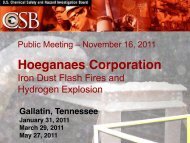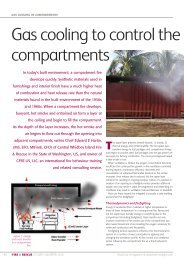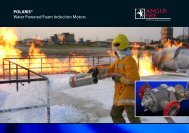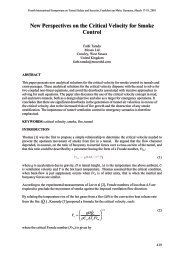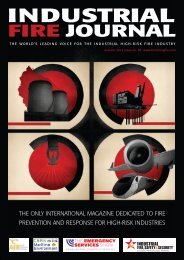Evacuation in Complex Environments - Industrial Fire Journal
Evacuation in Complex Environments - Industrial Fire Journal
Evacuation in Complex Environments - Industrial Fire Journal
Create successful ePaper yourself
Turn your PDF publications into a flip-book with our unique Google optimized e-Paper software.
Fourth International Symposium on Tunnel Safety and Security, Frankfurt am Ma<strong>in</strong>, Germany, March 17-19, 2010<br />
A comment from the participants dur<strong>in</strong>g discussions after the experiment revealed that<br />
communication between the participants on the TBM and between the participants on the TBM and<br />
persons outside the tunnel did not work properly. Communications over the radio dur<strong>in</strong>g the<br />
experiment was sometimes <strong>in</strong> Swedish, which made it difficult for participants not understand<strong>in</strong>g<br />
Swedish to follow the conversation. The formal procedure is that all communication shall be <strong>in</strong><br />
English.<br />
The participants also mentioned that there was a lack of <strong>in</strong>formation regard<strong>in</strong>g the situation from<br />
persons outside the tunnel. As there was no clear sign of a fire at the TBM the situation was rather<br />
ambiguous for the participants when they were sitt<strong>in</strong>g <strong>in</strong> the refuge chambers. One person also<br />
mentioned that he was anxious that someone had not noticed the fire alarm and still be at a place <strong>in</strong><br />
the TBM. The <strong>in</strong>formation about the exact number of persons on the TBM dur<strong>in</strong>g the experiment was<br />
uncerta<strong>in</strong> to the persons supposed to be the only ones at the mach<strong>in</strong>e.<br />
EVACUATION MODELLING<br />
The evacuation model used for <strong>in</strong>vestigat<strong>in</strong>g the possibility for tunnel workers to safely evacuate a<br />
tunnel compares the time for evacuation with the time for untenable conditions to occur. The model is<br />
based on a one-dimensional approach of smoke spread <strong>in</strong> the tunnel. This means that the smoke<br />
temperature, gas concentrations, visibility etc only depend of the distance from the fire and the time.<br />
The vertical variation is ignored and it is assumed that homogenous conditions apply, which is true at<br />
a distance from the fire. Close to the fire the model will provide a not so good prediction of the<br />
conditions.<br />
The smoke spread and subsequently the spread of toxic gases, temperature etc are calculated us<strong>in</strong>g the<br />
model provided by Ingason [6] and only need to have a HRR curve as an <strong>in</strong>put. It is assumed that the<br />
fire is located <strong>in</strong> the most remote part of the tunnel construction site, i.e. where the actual tunnel is<br />
excavated.<br />
The evacuation model is based on the assumption that a person cont<strong>in</strong>ues to move away from a fire,<br />
after an <strong>in</strong>itial pre-movement time, at a speed that depends on the smoke conditions, i.e. the visibility.<br />
Reduction <strong>in</strong> visibility reduces the walk<strong>in</strong>g speed. The person can <strong>in</strong>itially already be at a distance<br />
away from the fire. The movement cont<strong>in</strong>ues as long as the person is conscious and that depends on<br />
the accumulated toxic dose of the smoke gases, ma<strong>in</strong>ly carbon monoxide, carbon dioxide, low oxygen<br />
concentration and elevated temperature. The toxic accumulation is derived us<strong>in</strong>g the Fractional<br />
Effective Dose theory proposed by Purser [7]. It is assumed that unconsciousness occur when the<br />
person has accumulated a toxic dose equivalent to FED = 1,0.<br />
A prelim<strong>in</strong>ary analysis was made on the Hallandsås rail tunnel us<strong>in</strong>g a 30 MW fire as the first<br />
assumption. The fire peaks at 30 MW at approximately 13 m<strong>in</strong>utes from the fire start. The ventilation<br />
air supply to the construction site is assumed to result <strong>in</strong> a supply air velocity of 0,5 m/s across the<br />
tunnel section.<br />
Some of the results from this <strong>in</strong>itial analysis are presented <strong>in</strong> table 2 which show whether or not<br />
evacuation is possible and how far from the fire a safe refuge must be located.<br />
Table 2. Basic results from the sample analysis.<br />
Scenario Pre-movement<br />
time, sec<br />
Initial distance between<br />
person and fire, m<br />
Distance when FED<br />
= 1,0 occurs, m<br />
Time when FED =<br />
1,0 occurs, m<strong>in</strong>utes<br />
1 60 0 - never<br />
2 120 0 250 22<br />
3 120 50 - never<br />
4 120 30 - never<br />
5 150 30 300 25<br />
188



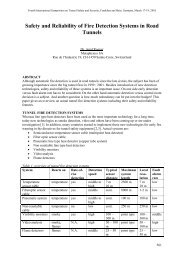

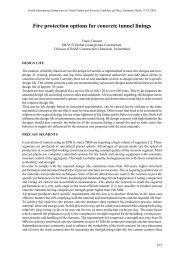
![30-37 TunnelsREV[1]rev.qxd - Industrial Fire Journal](https://img.yumpu.com/22237435/1/184x260/30-37-tunnelsrev1revqxd-industrial-fire-journal.jpg?quality=85)
